REMEMBERING DR. JOHN FOZDAR

2 July 1928 – 22 October 2022
We were grieved to learn of the passing of John Fozdar, consecrated servant of the Faith of God. His decades-long pioneering to different countries in Southeast Asia, in particular his move to Brunei, which won him the accolade of those listed in the Roll of Honour of Knights of Bahá’u’lláh, is recalled with great admiration. His manifold services, including as a member of the Continental Board of Counsellors in Asia and as a member of the Spiritual Assemblies of Malaysia and Sarawak, leave an enduring legacy for future generations. To his wife and children and other family members we extend our wholehearted condolences and assure them of our ardent supplications at the Sacred Threshold for the progress of his radiant soul in the eternal realms.
We call on you and the Spiritual Assemblies of Malaysia and Sabah as well as the Administrative Committee of Brunei to hold memorial gatherings in his honour in your respective communities and, by copy of this message, ask the National Spiritual Assembly of India to arrange a befitting service in the Bahá’í House of Worship in New Delhi.
– The Universal House of Justice to the Spiritual Assembly of the Bahá’ís of Sarawak dated 23 October 2022
Dr. John Khodadad Fozdar, born in Bombay on 2 July 1928 was one of the wondrous gems created by the wondrous hands of Bahá’u’lláh. He became a pioneer to Brunei in April 1954 and won the love of the Guardian who designated him a Knight of Bahá’u’lláh. He served the Cause in numerous capacities, winning the love and admiration of multitudes of individuals across the globe and institutions as well. His services and legacy are forever there to decorate the pages of history for all generations to come to admire and emulate. It is difficult to render adequate tribute to a believer so outstanding and precious.
Dr. John was the second son born into an illustrious family of Dr. Khodadad Muncherji Fozdar and Shirin Fozdar. In 1944 he enrolled in the pre-medical, inter-science course at a university in Ahmedabad and in 1944 entered the medical school at Bombay University. Upon completing his studies in medicine in India he joined his pioneer parents in June 1951 in Singapore, serving as a medical officer with the Singapore General Hospital for three years. He was elected to serve on the first Local Spiritual Assembly in Singapore formed in Riḍván 1952. The following year he attended the Intercontinental Conference held in New Delhi, India from 7 to 15 October with his parents Dr. Khodadad and Mrs. Shirin Fozdar, his brothers Jamshed and Minoo, and his sister Zena. While the family had already by then developed a strong ethic of dedication and service, the conference inspired them to apply themselves yet more ambitiously. Much could be written on each family member, yet this story confines itself to Dr. John alone. Responding to the call for pioneers at the conference, his father Dr. Khodadad Fozdar arose to pioneer to the Andaman Islands while Dr. John arose to pioneer in Brunei. He later wrote of that time:
“During the 10 Year Crusade conference in New Delhi in October 1953, there was a call for pioneers to arise and settle in the Sultanate of Brunei, which was one of the goal territories. The goal was assigned to Iran. Just a short while earlier, Iran, under Mossadegh, had nationalised the Anglo-Iranian Oil Company and driven the British out. Although the British came back and Mossadegh was out of power, the feeling against Iran was strong. I felt that it would not be possible for any Iranian to enter Brunei, which was a British Protectorate. I felt it would be shameful if the Guardian called for pioneers and no one could go. So I offered to go to Brunei and serve there. My offer was gladly accepted by the Hands of the Cause, Mr. Faizi and Dr. Ugo Giachery…”
The Guardian was pleased to learn of the father and son arising to fulfil the goals of the Ten Year Crusade and both were designated as Knights of Bahá’u’lláh.

The 1953 Intercontinental Conference in Delhi – the Fozdars getting ready to leave India. Standing L-R: Shirin Fozdar, Hand of the Cause of God Ugo Giachery, Zena Fozdar, Minoo Fozdar, John Fozdar and K. M. Fozdar. Squatting is Jamshed Fozdar.
After travelling on the S.S. Kimanis to Labuan, on 9 April, 1954 John made the final journey to Brunei at night. When his launch reached the jetty he saw a white man and a black man standing there – Knowing that two other Bahá’í pioneers had just arrived from the United States two months before, he walked up to them saying, “You must be Harry Clarke and Charles Duncan”. They were surprised as they did not know that he was arriving in Brunei. Harry and Charles were also designated as Knights of Baha’u’llah for Brunei.
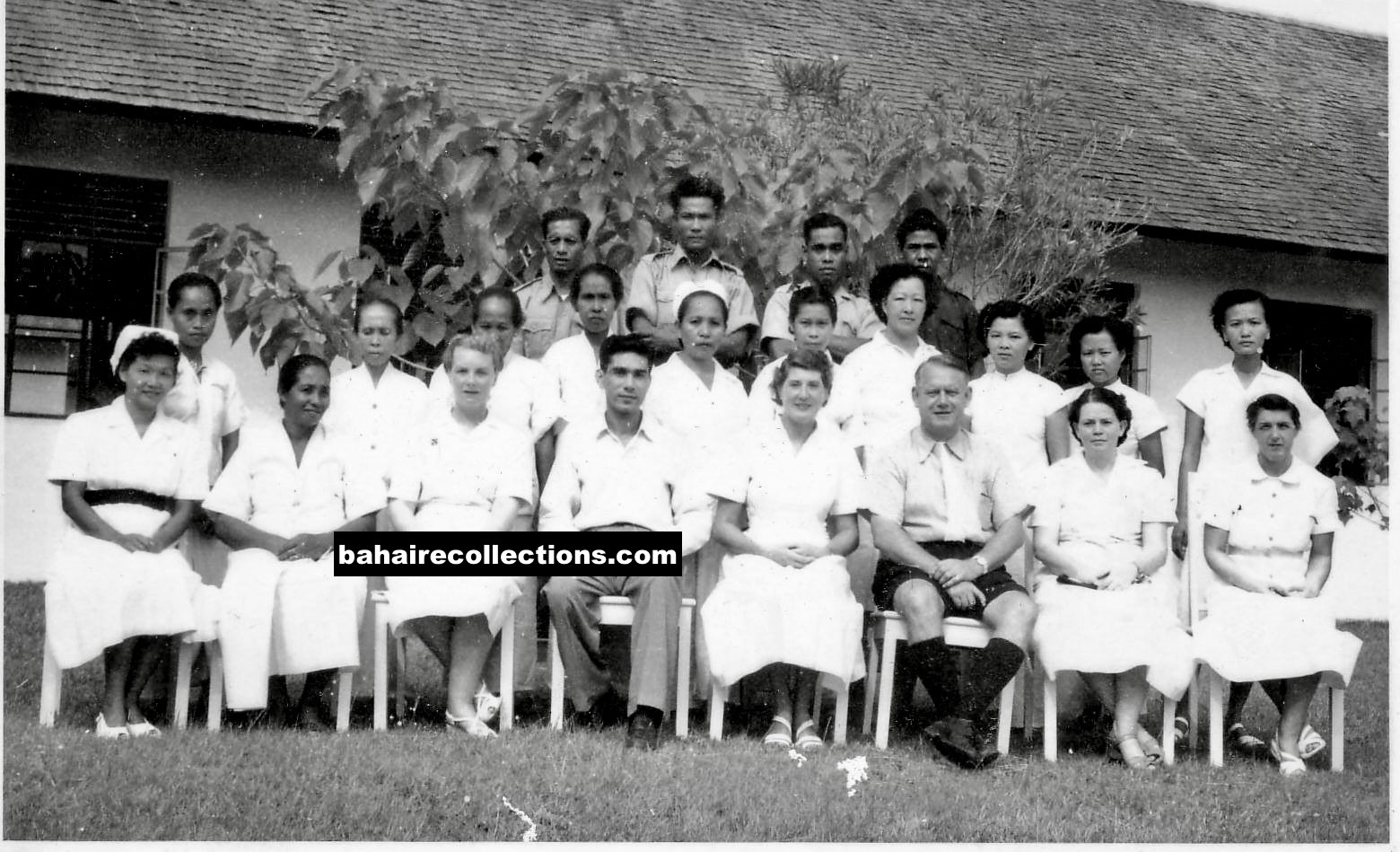
With Government Hospital staff of Brunei 1956-57. From right: Sister Betty Hurley, Dr. DeSilver, Dr. Vardy (Director of Medical Services). Dr. John is seated fourth from left
Dr. John worked in the government hospital of Brunei. His younger brother Minoo arrived in Singapore on a stopover in order to proceed to the Cocos Keeling Islands that the Guardian had wanted him to go but owing to some miscommunications he was stranded in there. Then on the invitation of John he went to Brunei in December 1954 and worked with the Brunei government as an accountant in the Treasury until 1970, when he left for Australia. The first believer in Brunei was one Mr. Cheok, a businessman from the Chinese community.
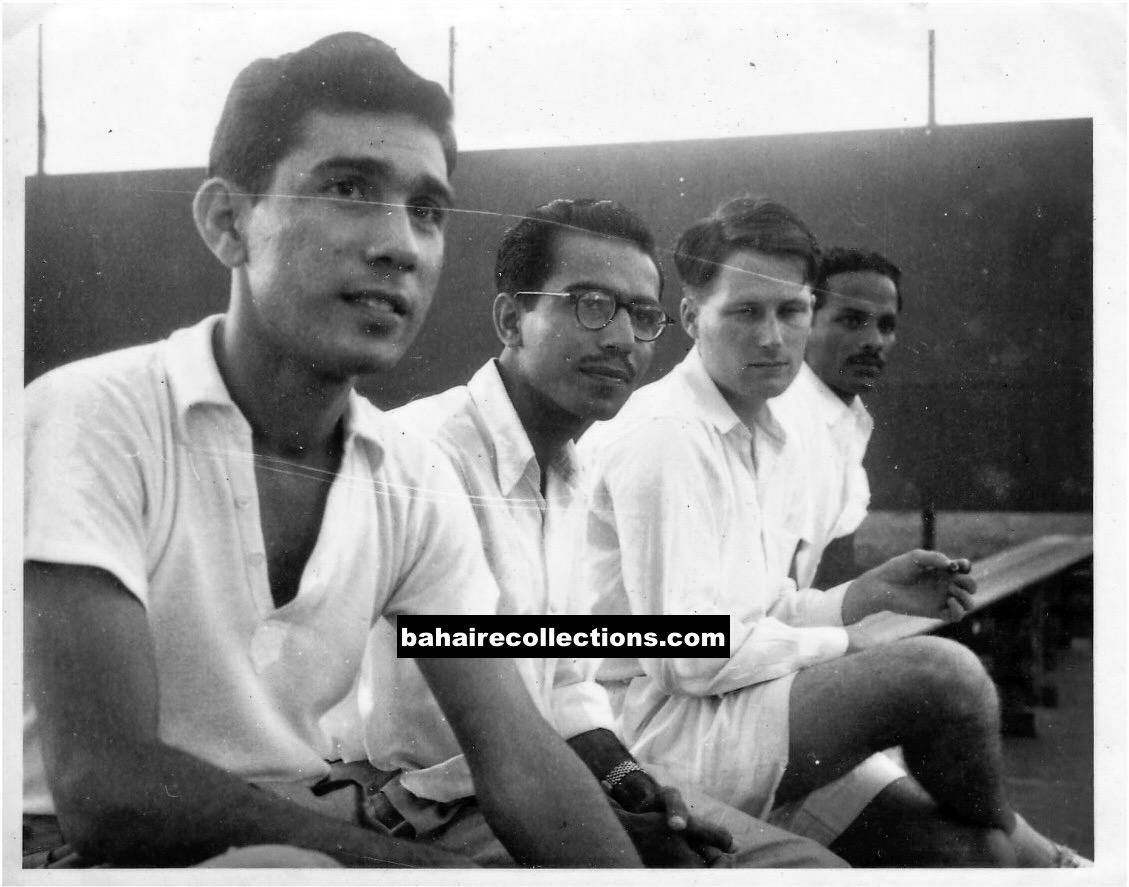
Brunei, 1958. L-R: Dr. John, Minoo, Patrick Adamson a school teacher and Rajaratnam, the Airport Manager
When in Singapore in early 1950s and after entering Brunei in 1954, Dr. John continued participate in some of the events in Malaya. And now let us follow some recollections taken from the notes of Dr. John of his early days in Brunei:
In a small place like Brunei, it was easy to get to know everyone. My relations with the British authorities were very cordial, as I was well-placed. Relations with the Sultan were also warm, and we knew one another, but language was a barrier, and I was woefully ignorant about protocol. He knew about the Faith in our short conversations. Other prominent Malays who were very warm towards me were the Penghiran Bendahara and Penghiran Pemancha. Also, the Chief Kathi of Brunei Pengiran Mohd. Salleh bin Pengiran Haji Mohd. and his son-in-law, Pengiran Dato Kamaluddin bin Haji Metussin and his family were friends and patients of mine. On one occasion, the chief Kathi asked me if the Bahá’ís would ask for land for the Faith. In my ignorance, I said that Bahá’ís did not accept gifts from non-Bahá’ís, and he was very surprised. He would invite me to his house in Kampong Ayer in Brunei and he was friendly. Pehin Shahbandar Haji Ahmad was also a good friend. After staying in Brunei for more than two years, I was nearing the end of my contract with the Government of Brunei. I had to make plans for furthering my career. I informed the authorities that it was my intention to leave on completion of my contract and go to UK to finish my surgical studies. Of course, the people of Brunei were unhappy. I had got to know everyone. All strata of the population were keen that I stay there. The palace, the government, the staff, the population were genuinely sorry that I was leaving Brunei. I was told that delegations had seen the Sultan and the Prime Minister and urged them to try and retain my services as a doctor in Brunei. The Prime Minister, Datuk Ibrahim Ja’afar, consulted with the palace and the British authorities, and made me an offer which was difficult to reject. He said that if the government were to send me to UK on a government scholarship, would I consent to go back and serve them for a further five years. I remember my feelings that everywhere else, pioneers are struggling so hard to remain at their posts with the fear of being expelled – and here, I was being invited by a Muslim government to go back by special invitation. I informed Datuk Ibrahim that I would agree to such an offer. He then asked me to write to the government, asking for a scholarship to study and consenting to be bound to return for a further five years of service. And I did this. I learned afterwards that I was the first non-Brunei citizen to be sent on a Brunei government scholarship. As usual, I was asked to furnish two sureties about my return. My two friends, the State Electrical Engineer Mr. Rajaratnam and Shaykh Mohammad agreed to furnish the sureties. I wrote to the Beloved Guardian to state my intention and to seek his guidance and instructions. I was informed by Hand of the Cause Mr. Leroy Ioas that, as the Faith was established in Brunei, the Beloved Guardian approved my going to UK for further study and that I would return to Brunei to continue my service.
The Brunei population knew vaguely about Bahá’í by now. They knew that I was not a Christian or anything else, but a Bahá’í. They knew the name. Also, at all social events, I did not drink alcohol and it was noticeable. I was not Muslim either, but something else. The government may have first heard of the name in 1955 when the instructions from Haifa asked all Bahá’í localities to send a message to the Shah of Iran asking for justice following the attempted demolition of the dome of the Haziratu’l Quds in Tehran. I also sent off a telegram as instructed. Two days later, while playing tennis with the Minister of Posts, Penghiran Kerma Indra, he told me that I had sent a cable to the Shah of Iran. I asked him how he knew about it, and he said that he had to vet the message to a Head of State, and he also consulted with the British authorities. He got the clearance, and the message was sent off. We informed the World Centre about the actions taken.
In April 1957, Dr. John Fozdar left for the United Kingdom to pursue studies to obtain a Fellowship of the Royal College of Surgeons (FRCS). In the United Kingdom he stayed in the Indian Students Hostel but later moved and worked in Cardiff where he was a boarder with David and Marian Hofman. He passed his examinations in Edinburgh. In Riḍván 1957, when Dr. John was away for further studies, the first Local Spiritual Assembly was elected in Brunei with members, among others, Mr. Minoo Fozdar, Mr. Chin Yun Sang, Miss Kong, Mr. Cheok Chin Hong, Mr. Robert Cheok, Mr. Rama Tribhuvan and Mr. Siah Teck Heng.
Meanwhile Dr. John attended the 1957 Irish Summer School, where he met Miss Margarethe Frener for the first time. They were married on 22 November 1958 during a Bahá’í weekend school in Torquay, England (with the civil registration being in Cardiff, Wales).
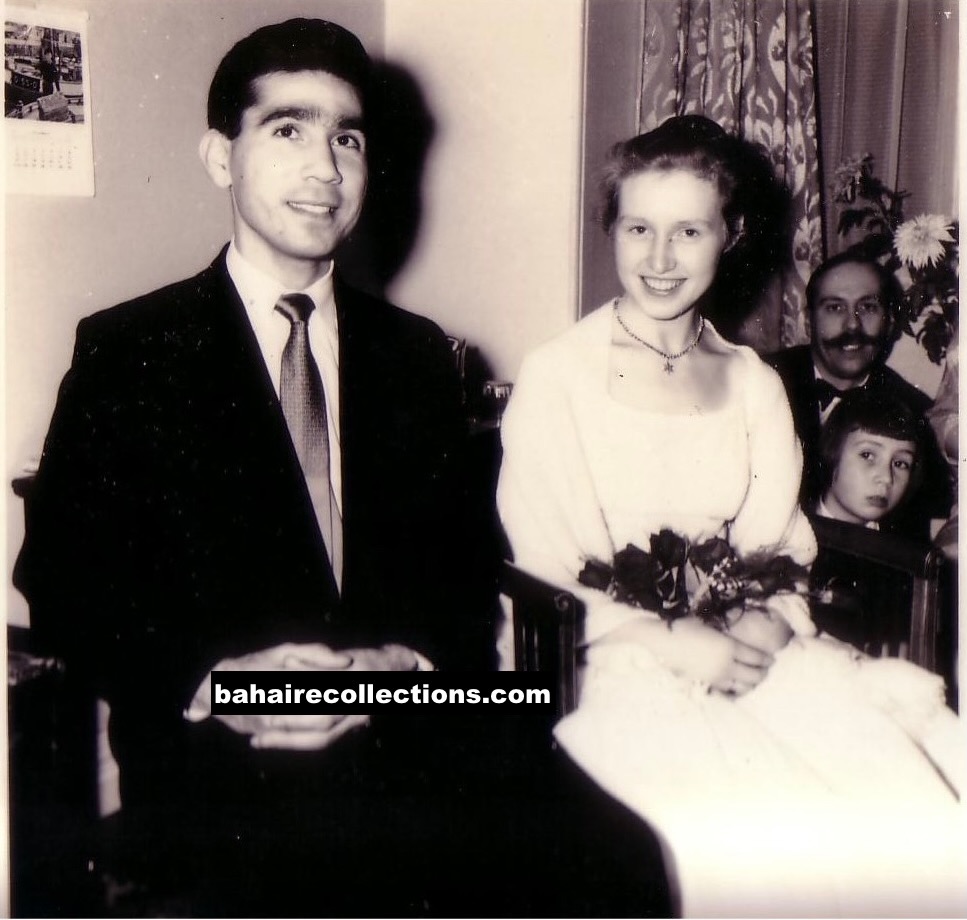
Their marriage in Torquay, England
Travelling to their pioneering post in Brunei, the couple undertook pilgrimage to the Holy Land in November 1959 together with their three-month old daughter Shirin.
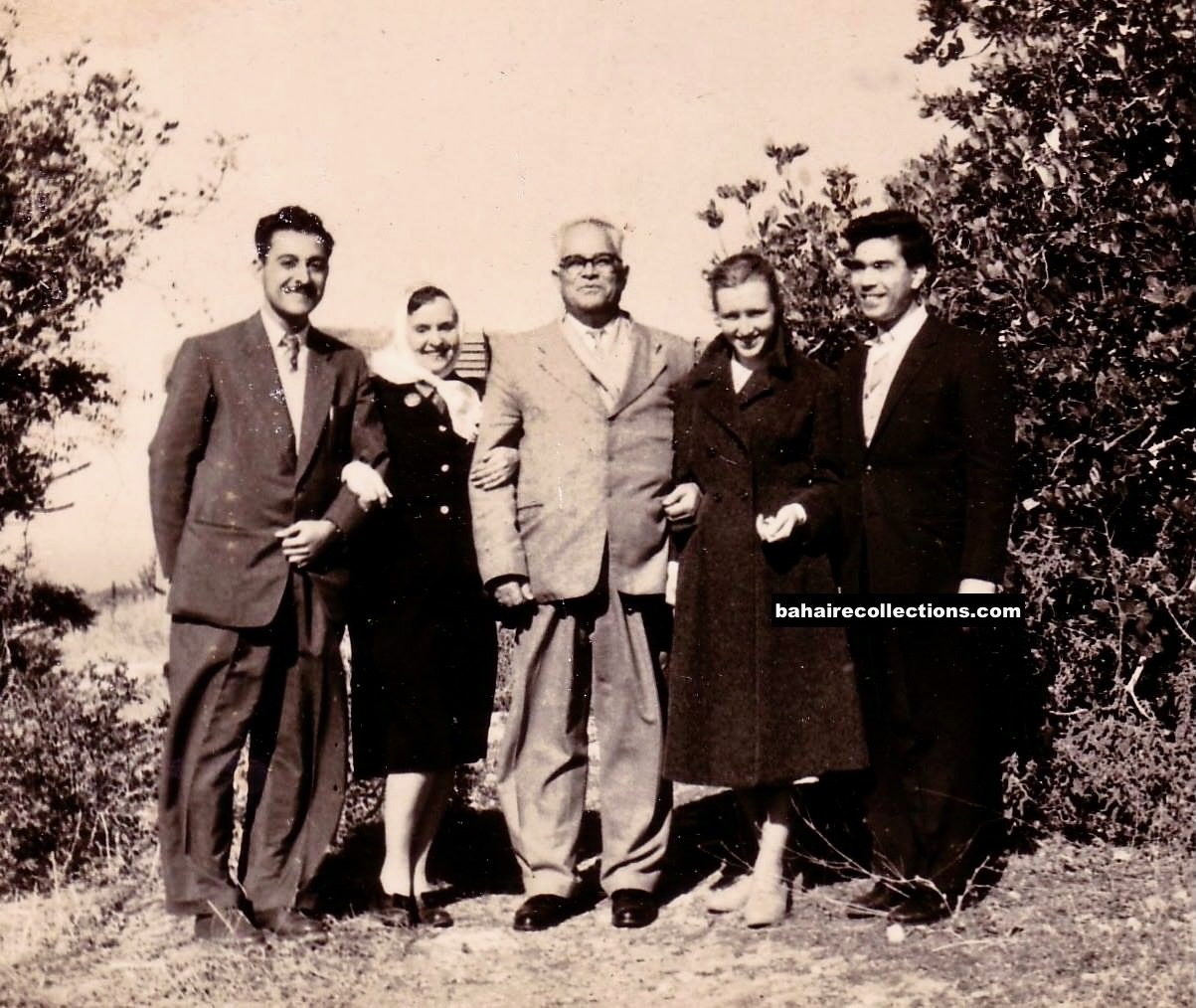
Pilgrimage to the Holy Land in November 1959. In the middle is Hand of the Cause of God Mr. Jalal Khazeh and to his left are Dr. John and Grete
From the Holy Land they travelled to Brunei after passing through India and Singapore. There Dr John started to play a greater role in Bahá’í activities in Brunei and in the entire region of Southeast Asia. Upon returning to Brunei Dr. John again worked in the government hospital, this time as a Specialist Surgeon. His first year back with his new wife and young daughter was happy and uneventful. Introducing people to the Faith was an important part of their lives. However, in 1960 a new political situation changed the situation dramatically. Many of the incumbent medical heads of department were replaced in line with race-based appointment policies, and there was a strong drive to similarly replace the doctors then in service of the Brunei government. The new State Medical Officer made Dr. John’s situation very difficult, through a combination of removing trained staff and equipment from his surgical unit, and also vigorously encouraging patients to sue Dr. John for what he said was professional negligence.
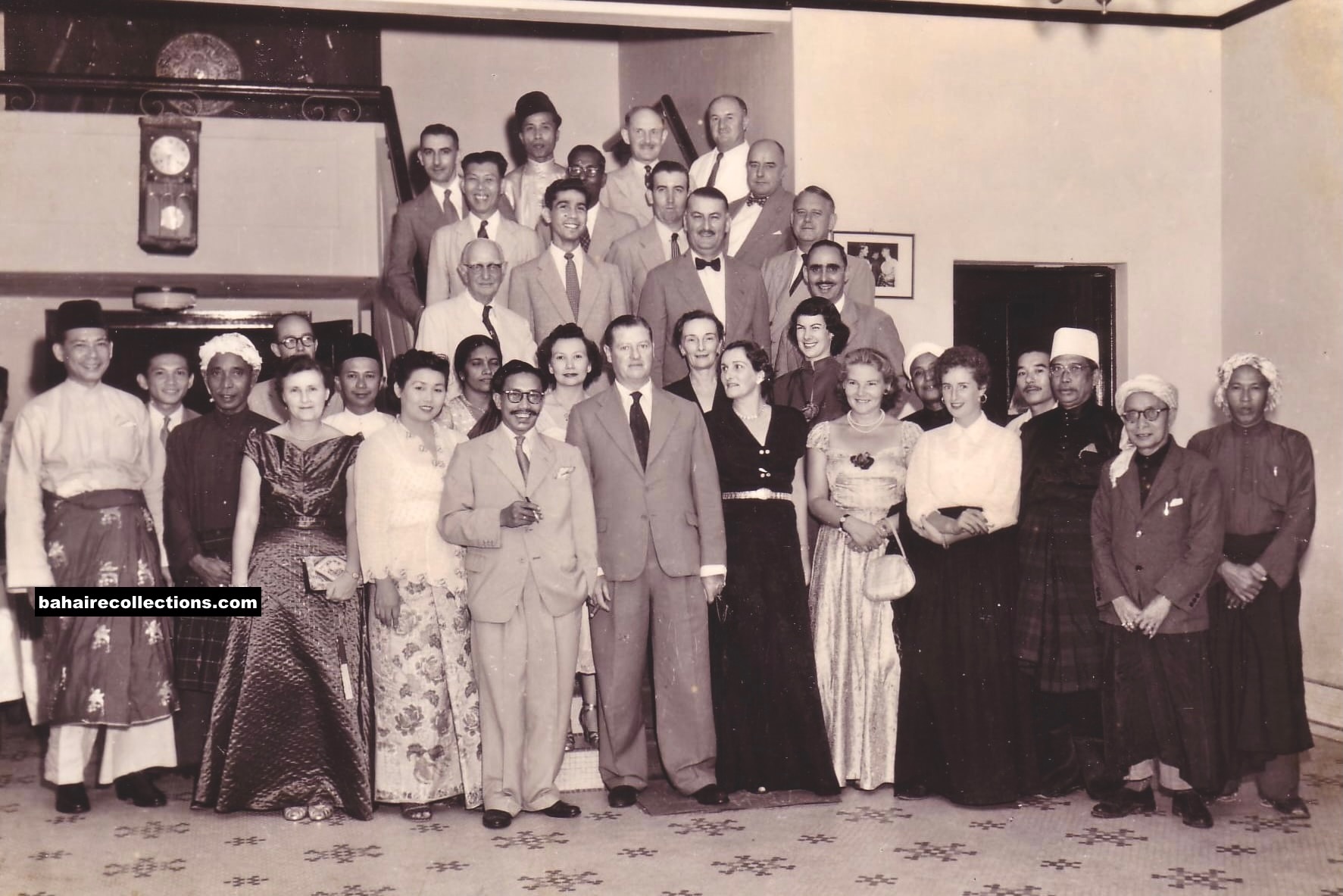
Reception with Omar Ali Saifudden III Sultan of Brunei, in the 1950s. Dr. John stands second from left in the third row
Dr. John later recalled:
Having to work under such pressures, a heavy workload because we were doing operations never been done before in Brunei, with largely untrained staff and a constant shortage of equipment, I developed bleeding gastric ulcers and was hospitalised in Shell Oil Company’s Seria hospital … In every calamity, there is some good. While I was lying in Seria hospital, I was approached by a hospital assistant who was into Sarawak politics. He would ask me to vet the language of the constitution he was drawing up for his political party. We would chat for long periods during the night. I advised him to be a statesman for the whole country and not merely a politician promoting narrow interests.
This man was Dato Stephen Kalong Ningkan, who subsequently became the first Chief Minister of Sarawak and the founder of the Sarawak National Alliance Party (SNAP). At various social functions in Sarawak, he would always introduce me as Dr. Fozdar who had been his patient. The other guests would assume that he was drunk because I was the doctor and he was no longer a hospital assistant, but Chief Minister… I would then explain about our first meetings in Seria Shell hospital. In the early years, when we had difficulty bringing in travelling teachers from Malaysia, he helped to smooth the way. He was a good personal friend …
Due to the deteriorating conditions in which he was serving, the family proposed to the Custodians in the Holy Land that they leave Brunei – this was accepted. Leaving necessitated having to break the terms of his Brunei government scholarship and repaying the financial bond. This was done with difficulty and great sacrifice – John’s mother Shirin even sold her house in Singapore to assist with the repayment.
From 1960 to 1963 Dr. John was elected to serve on the Regional Spiritual Assembly of the Bahá’ís of South East Asia, which was the administrative body for Borneo, Brunei, Cambodia, Indonesia, Laos, Malaya, Mentawai Islands, Philippines Islands, Portuguese Timor, Sarawak, Thailand and Vietnam before this body was dissolved in 1964 to give way to the election of the National Spiritual Assemblies for those respective countries. During this period on the Regional Spiritual Assembly, his mother Shirin Fozdar and his eldest brother Jamshed were also members. This Regional Spiritual Assembly came out with its first official news bulletin called the “Bahá’í Newsletter of the Regional Spiritual Assembly of South East Asia” from the first year of its formation in 1957. When the Bahá’í Newsletter took the name of “Bahá’í News” Dr. John Fozdar edited this it from 1962 to 1964. It published interesting historical records in the form of articles, news items, quotations from the holy writings, and letters from the Hands of the Cause of God in the Holy Land. While in circulation this newsletter was highly popular and in demand, bringing much pleasure to the Hands of the Cause in the Holy Land.
During Riḍván 1961, Dr. John was elected to the Local Spiritual Assembly of Brunei and in June that year his family moved via Labuan to Jesselton (now Kota Kinabalu) in what was then the colony of British North Borneo (now the Malaysian state of Sabah). He there created indelible marks in the historical map of the Faith in many ways, while working in the Queen Elizabeth Hospital. During his nine months in Jessleton, he was able to visit places such as Papar, Kota Belud, Tamparuli, Ranau and Tenom and was able to move with those in high positions including the Governor himself. The Fozdars were often invited socially for dinners and teas and got to know most of the prominent, local Chinese businessmen and newspaper editors and reporters and of course the local politicians, one of them being Donald Stephens, first Chief Minister of Sabah. There were many opportunities to talk about the Faith to patients and he had many firesides with patients and staff.

Local Spiritual Assembly of Brunei in 1961. Seated at left is Dr. John. Standing second from right is Minoo with Chin Yun Sang to his right
After serving for a year in Jesselton, Dr. John moved to Sandakan in early 1962, taking the newly created post of Surgeon East Coast at the Duchess of Kent Hospital. He introduced many new elements of surgical practice there, including a blood bank in collaboration with the Red Cross organisation, separate wards for medical and surgical patients, an upgraded surgical unit and a collection of preserved materials as surgical training aids.
The Fozdars became the first believers in that town and were successful in creating a strong community there. Their government quarters were used as a place for meetings and Bahá’í activities; regular firesides were held there. As a doctor, John saw many patients and hospital staff, and he found it easy to talk to them about the Faith. Dr. John was a very popular doctor, and had many good friends among doctors, staff and others he got to know. The earlier declarations led to a kind of natural chain effect, where the Chinese contacts spoke to family and friends, and family after family joined. Young children attract young children, and families would get together at weekends for curry lunches (with some adults afterwards leaving to play mahjong!), and everyone just enjoying the company and lunch. Many people in Sandakan knew about a doctor who taught a new religion in the Duchess of Kent Hospital. Through the teaching activities of the Fozdars there, one Koh Yaw Han became the first believer to enrol in Sandakan and the first believer in Sabah. He was also the first Chinese Bahá’í there. This was followed by another lady, Madam Foo Choi Yun, the first lady to declare in Sandakan.
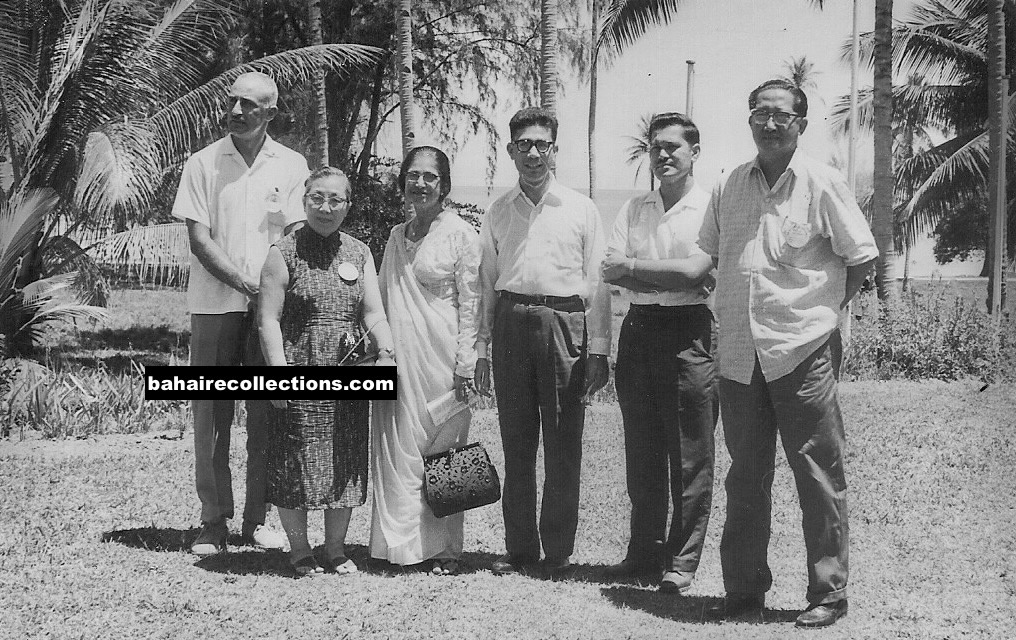
Summer School in Port Dickson, 1961. L-R: Kamran Samimi, Mrs. George Lee, Shirin Fozdar, Dr. John, Jamshed Fozdar, and Leong Tat Chee. While in Brunei Dr. John kept participating in activities in Malaya
Within a year, there was a sizeable Bahá’í community in Sandakan mainly comprising businessmen and their families. A children class was started by Mrs. Grete Fozdar and Miss Annie Tan. Every Sunday afternoon about 20 children would come to their house to have their studies. During weekly firesides Dr. John Fozdar spoke about the Faith in English and Annie Tan would translate into Chinese. On 13 July 1962, the first Local Spiritual Assembly was formed in Sandakan, with the Fozdars serving on this Assembly. Bahá’í Holy days and anniversaries were also celebrated, and many friends and family members were invited for the occasions. The Bahá’í population at that time was around 60. It was the largest Chinese Bahá’í Community in Borneo, and perhaps in the world then too.
Through the efforts of Dr. John, Sandakan also obtained a Bahá’í cemetery. He was audacious and bold in requesting for a cemetery from the authorities. Many months passed and the government did not respond. A Bahá’í engineer, the son of an elderly Bahá’í, Madam Lai, drowned in a stream in1963. With the death of this Bahá’í, Dr. Fozdar approached Ben Stephens (brother of Donald, later Chief Minister of Sabah) who represented the British authorities at that time and the burial ground papers were immediately sorted out. This was the first Bahá’í burial ground in Sabah. It is also interesting to note that the Local Spiritual Assembly of the Bahá’ís of Sandakan was registered with the Registrar of Societies on 19 February 1963. Dr. John’s friend, one Mr. Yu How Chee was instrumental in registering the Sandakan Local Spiritual Assembly.
In Riḍván 1963, Dr. John along with a few other members of the Regional Spiritual Assembly represented this body in the election of the First Universal House of Justice in Haifa. Following the election of the Supreme Body he also attended the first World Congress in London, where he along with other Knights of Bahá’u’lláh were celebrated for arising to fulfil the goals of the Ten Year Crusade.
In October 1964, the family moved to Kuching, Sarawak. The Sandakan community threw a farewell party to the Fozdar family before they left.

Farewell dinner for Dr. John and Grete, Sandakan, 1964
In Kuching the family played a major role in the progress of the Faith. They first rented two semi-detached shop lots at Mile 2½ Rock Road, Kuching, moving at first into one side of the building which doubled as their home and as the first Bahá’í Centre in Kuching. Rent was cheap, as the buildings were thought to be haunted. Dr. John opened a private clinic, the “Fozdar Clinic”, at the Padungan Garden Arcade on Song Thian Cheok Road, moving after three months to a better location on Khoo Hun Yeang Street in the centre of Kuching, opposite the bus station and directly across the river from Malay kampungs. In addition, Dr. John in 1966 also opened the New Era Nursing and Maternity Home in the semi-detached building adjacent to their home on Rock Road. In 1970 the clinic moved to Jawa Road (now Jalan P. Ramlee), and was renamed Poliklinik. He went into partnership with Dr Si-hoe Kok Wan of Key Clinic, Padungan (the name was changed to Poliklinik). New partners joined over time, including Dr. Chua, Dr. Tan Yaw Kwang and Dr. Nadia Lim. With the coming of the partners Dr John was able to devote more time for the Faith. Dr. John would work long hours for six days in a week and half the day on Sunday. Life was hectic for him and yet he found time to serve.

Grete with her children Shirin and Kamal, and mother-in-law Shirin Fozdar holding Ian at 2 1/2 mile Rock Road Kuching in late 1966
With the move to Kuching a new chapter started in their lives and the history of the Faith in Sarawak, and by extension the whole region. His eldest brother Jamshed Fozdar had laid a strong foundation for the Cause in Sarawak in bringing in the first group of believers and established the first Local Spiritual Assembly for Kuching in Riḍván 1953. With Jamshed having gone to Vietnam in 1954 to carry out his services there and in Indochina, the task fell upon John and Grete to take over the building of the nascent community.
In the intervening time between Jamshed Fozdar and family departure and the arrival of Dr John Fozdar and family, several pioneers arrived from overseas to support the young Bahá’í community of Kuching. From India Mr. Lele, from the United States Miss. Marjorie Lighthall (via Laos, later married Minoo Fozdar in Brunei), Doree Thomas, Earl Mock, among others, while others from Malaya and Brunei came to travel teach. Other towns like Kanowit, Kapit and Sibu were opened to the Faith by Bahá’ís from Kuching visiting relatives or being transferred in their job.
By the time Dr. John and family arrived in Kuching there were already Local Spiritual Assemblies in Kanowit, Kapit and Sibu apart from Kuching. All early pioneers and travel teachers from other countries had left, leaving only Harlan Lang from the United States who had arrived in February of 1964. The Kuching Community had changed little since the time Jamshed Fozdar and family left, but the Local Assembly was regularly elected every year. Harlan Lang and his wife Chiang Kim Ling from West Malaysia were very active members of the Kuching Community until they left in 1965 to pioneer to one of the Pacific Islands.
But there were also many more Bahá’ís in Sarawak, far from the city and deep in the interior, in longhouses along the Sungai Gaat (Gaat River, a tributary of the Baleh and Rejang rivers). The Faith had been introduced there by local men who had accepted the Faith when working in Brunei, before returning home. Yankee Leong and M. Maniam (from West Malaysia) and Abolfazl Bijan Bayzaee (a travel teacher from Iran) had travelled there in 1963, at the request of the Regional Assembly of South East Asia, to meet with, deepen and consolidate believers here, with Maniam and Bayzaee staying for 9 months. However, by the time of the Fozdars arrival in Sarawak, all the travel teachers had left. The only contact was by post through Minoo and Marjorie from Brunei with some members of the Local Spiritual Assemblies of Kuching and Kapit and a local travel teacher stationed in Kapit by the name of Lalok ak Lian, with little supervision and coordination possible.
When Dr. John’s family moved to Sarawak, the Faith was clearly still in an early stage of its development, and he was conscious of meeting the goals of the Nine Year Plan. He was the only member of the National Spiritual Assembly of Malaysia residing in the vast area of East Malaysia in the 1960s and had shouldered heavy responsibilities to ensure the development of the Faith there. His appeal to the community in West Malaysia was published in the Nineteen Day Feast newsletter of the month of Ilm (Knowledge) in December 1966.
The opportunities for teaching and consolidation may not be available much longer. This thought grieves me a lot, because it is so easy to win the goals of the Plan if only we had a few travelling teachers. If there are capable young Bahá’í teachers in Malaya, we would like them to come and help us.
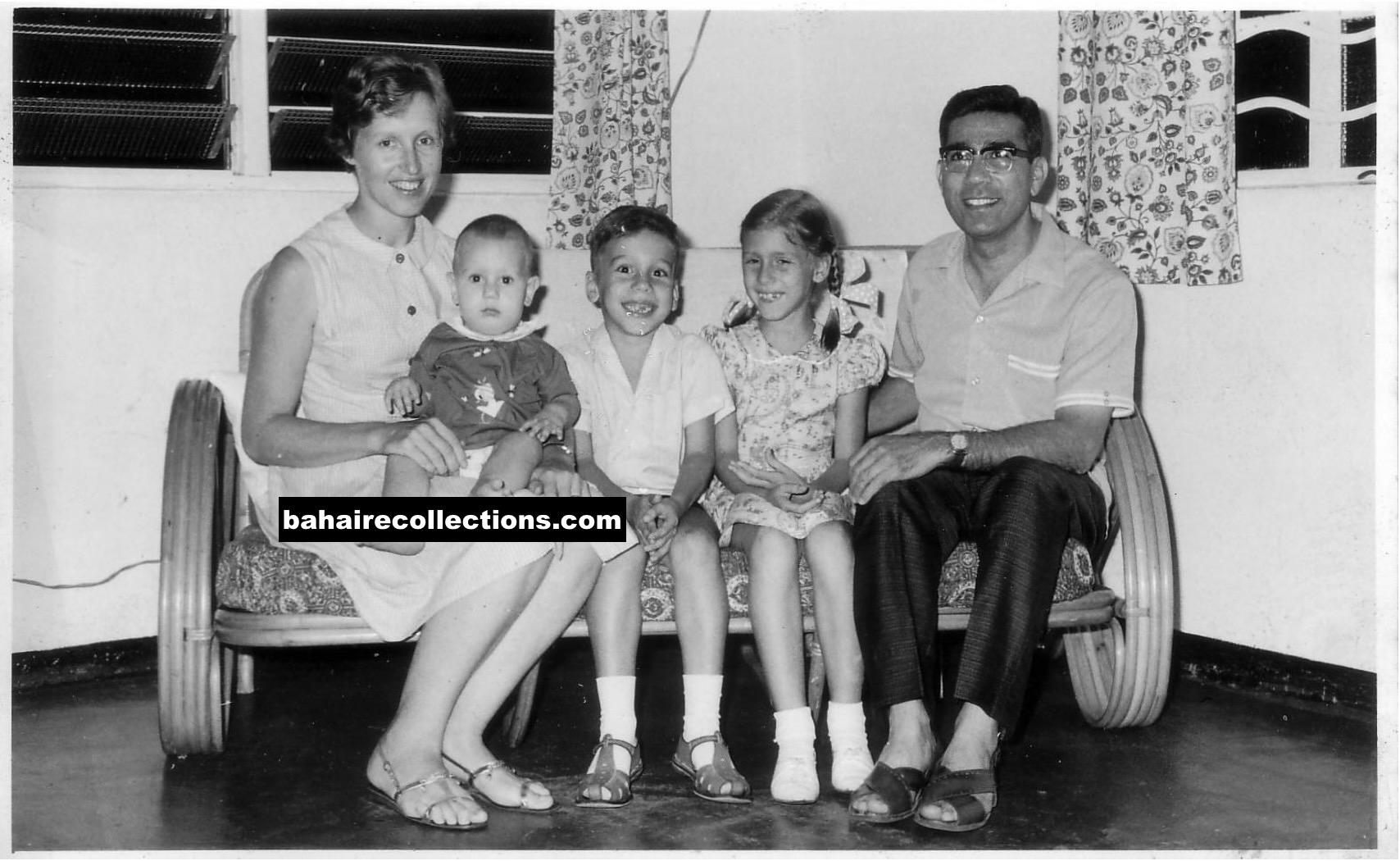
Settling down in Kuching in 1967. L-R: Grete with Ian on her lap, Kamal, Shirin and Dr. John
In 1967 Maniam returned and settled after an absence of 4 years in West Malaysia, concentrating on revitalising communities in central Sarawak, particularly Sungai Gaat. And from 1968 many more believers from West Malaysia started coming to Sarawak for travel teaching, or on transfer with their work. There was a very run-down and written-off building on 9 Rodway Road, belonging to the Chartered Bank, which was standing vacant. Since Dr. John was doing well in his practice, the bank gave him a loan and this spacious property was bought. This iconic building remains the house where many historical events took place. The new Bahá’í Centre became a centre of activity, as it was easily accessible, and the believers could meet and organise themselves for activities.
In 1970 Bahá’í firesides were started at the Rodway Road home, commencing each Wednesday at 8 pm. They were always popular and well attended, and the youth often brought their friends. Grete was responsible for music, devotionals and particularly refreshments. During conversations after formal meetings, some friends would gather around him because he always knew and talked about things which were important, interesting and new to them.
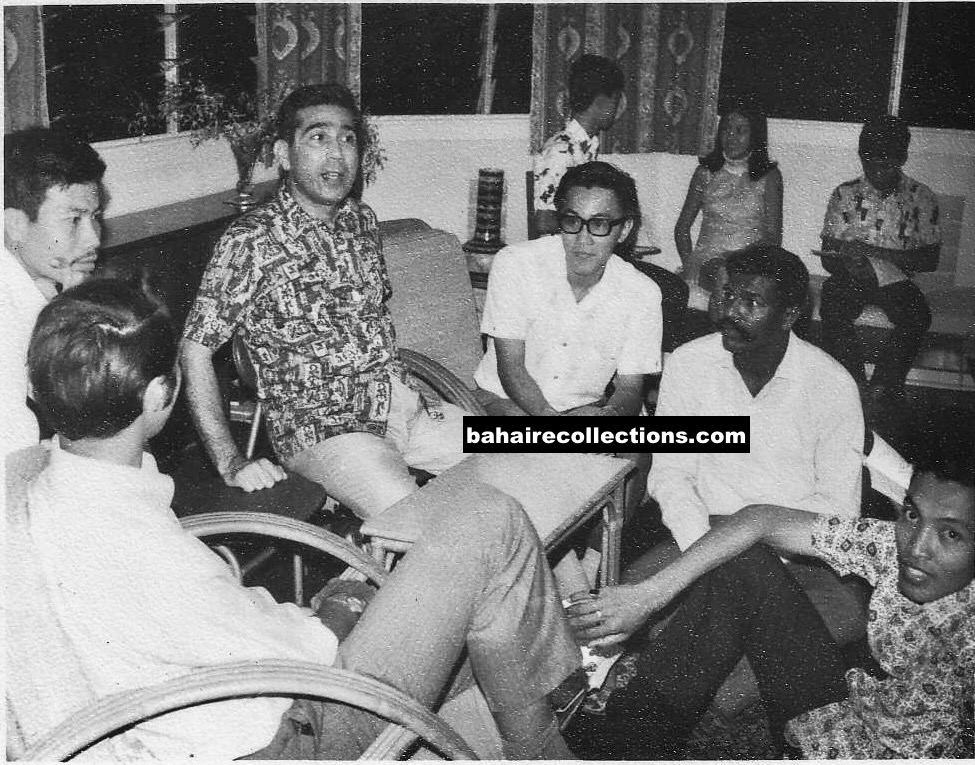
Discussions with Dr. John. On the floor is Flight Captain Choo Yeok Boon with Commando Arumugam to his right. First on the sofa on the left facing Dr. John is Matthews Wagner, a new believer
When 9-Day Institute was introduced by Mr. Jenabe Caldwell, the house was also in demand because of the big garden and large floor space being able to accommodate all who did not mind roughing it a bit. The home accommodated numerous travel teachers, pioneers, and visitors who usually stayed for a few days before going to their respective destinations.
Dr. John became a towering figure, and the days were filled with landmark events and milestones for the Cause. The fifty eight years of Dr. John’s stay in Sarawak were filled with restless activities for the Cause in diverse ways. For example, from 1969 Radio Sarawak, a branch of Radio Malaysia, even started broadcasting regular Bahá’í programs in a slot that was meant for various religions. It was Dr. John who hosted, every 5 weeks, and until the mid-1980s, this half hour Bahá’í broadcast on that radio station. And it was the work of Dr. John in getting this started, with listeners gaining much authentic and first-hand information on the Faith.
When the first National Spiritual Assembly of Malaysia comprising Peninsula Malaysia, Singapore, Sabah, Sarawak and Brunei with its seat in Kuala Lumpur was elected in 1964, Dr. John, Grete Fozdar, Minoo Fozdar and Mrs. Marjorie Fozdar were all elected to this body, with Dr. John elected as its Chairman. He served on this National Spiritual Assembly continuously until 1972 when two separate National Spiritual Assemblies were elected – one for West Malaysia and the other for East Malaysia, consisting of Sabah and Sarawak and Brunei. Dr John was elected to serve in the latter that existed for the 1972 and 1973. But in 1974 the National Spiritual Assembly of East Malaysia and Brunei was dissolved, Consequently, Sabah, Sarawak and West Malaysia had one National Spiritual Assembly, called the Spiritual Assembly of the Bahá’ís of Malaysia. Dr. John left this national institution in 1980 when the Universal House of Justice appointed him to the Continental Board of Counsellors. He served in the new capacity from 26 November 1980 to 26 November 1995.

First National Spiritual Assembly of Malaysia, 1964. Seated L-R: Grete, Amatu’l-Bahá Rúhíyyih Khánum, representing the Supreme Body, Mrs. George Lee and Marjorie Minoo. Standing L-R: Yankee Leong, Harlan Lang, Dr. John, Leong Tat Chee, Minoo and Chin Yun Sang
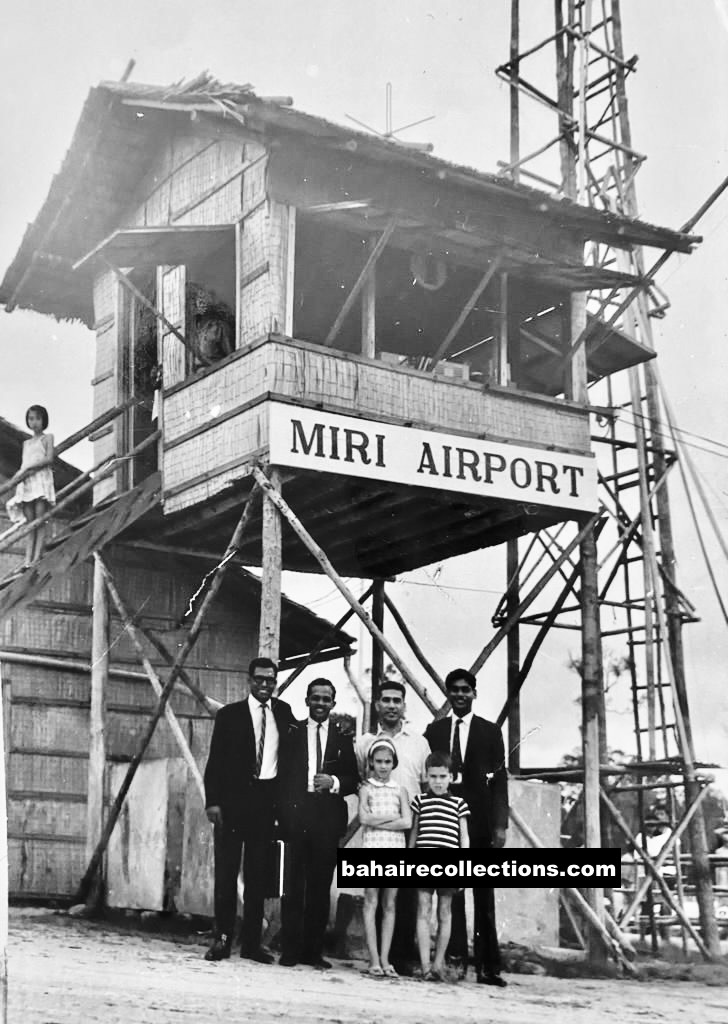
Visit by members of the National Spiritual Assembly of Malaysia to East Malaysia, December 1968. Standing L-R at Miri Airport: Inbum Chinniah, Tony Fernandez, Dr. John Fozdar and S. Nagaratnam. The two children L-R: Shirin and Kamal

Oceanic Conference of the South China Seas, Singapore 1971. Dr. John conversing with Amatu’l-Bahá Rúhíyyih Khánum at a similar conference in Monrovia. To his left are S. Ravichandran assisting in the connection, Inbum Chinniah, Hand of the Cause of God Enoch Olinga and Counsellor Momtazi from Japan

First National Spiritual Assembly of East Malaysia and Brunei. 1972. Seated L-R: Choo Yeok Boon, Dr. John, Rusi Irani, M. Maniam. Standing L-R: Ragai Lang, P. Thinathayallam, Lim Boon Huat, G. Kuppusamy and Sapong Andar
He was well respected as a Counsellor, and it was inspiring to listen to his talks at gatherings, especially at conventions, where he spoke with the clarity and eloquence that came naturally to him. As a Counsellor he participated in the national conventions of neighbouring countries and also was the representative of the community at the 41st Session of the Economic and Social Commission for Asia and the Pacific (ESCAP), held in Bangkok, from 19-29 March 1985. On being relieved from the Continental Board of Counsellors, Dr. John served on the Spiritual Assembly of the Bahá’ís of Sarawak from 1998 to 2005.

International Convention in Haifa, 1983. L-R: Mrs. Bharthi Gandhi, Khodadad Vajdi, Zena Sorabjee, Counsellor Dr. John, Shirin Fozdar and Dr. Jagdish Gandhi
Tribute by Counsellor Dr. John at the memorial service for Yankee Leong held in Ipoh, Perak, June 1986

Knights of Bahá’u’lláh Charles Duncan and Dr. John meet at the inauguration of the Bahá’í House of Worship in New Delhi, India, December 1986
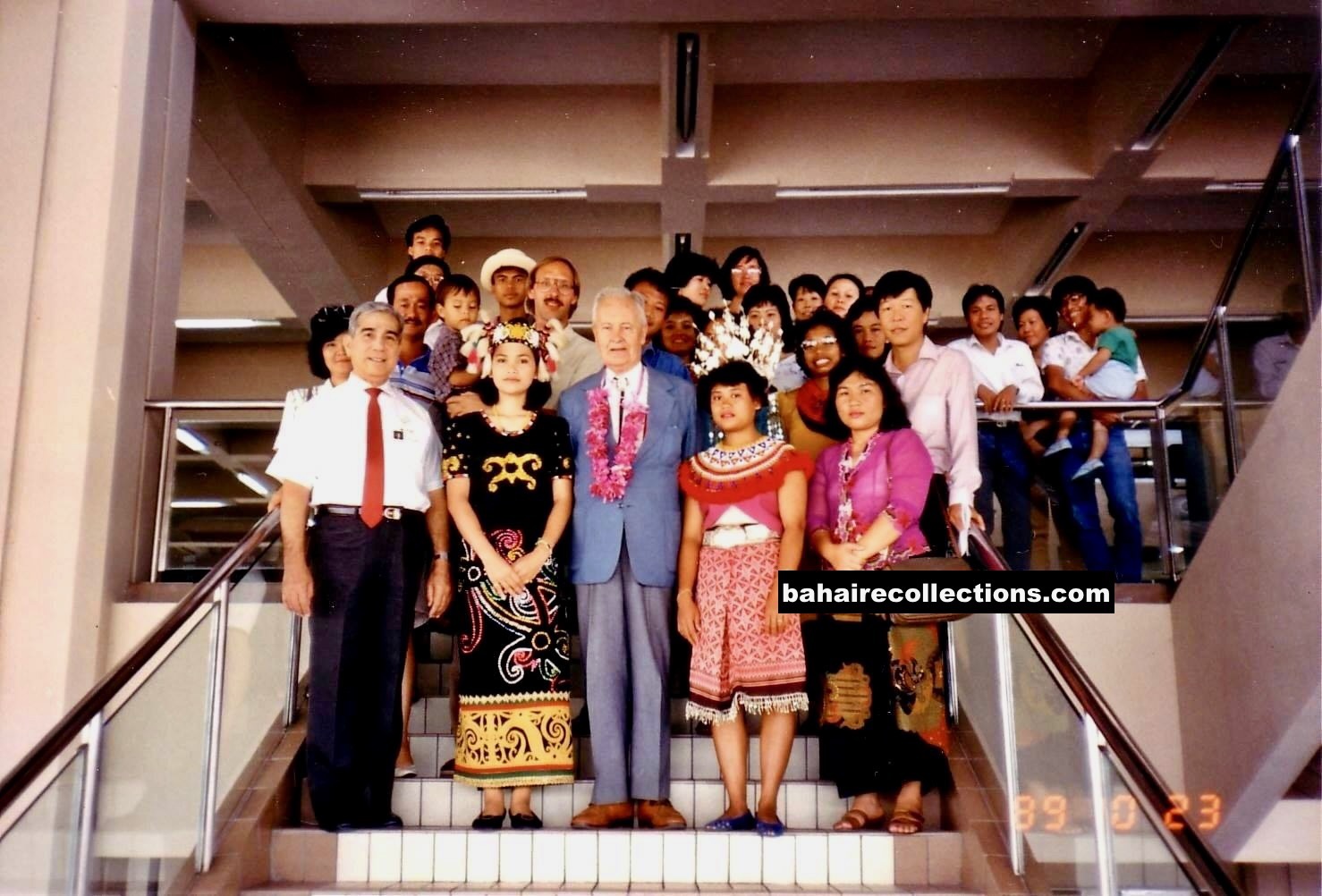 Welcoming the arrival of Mr. David Hofman in Kuching, Sarawak, 1989. He was the first retired member of the Supreme Body to visit Sarawak
Welcoming the arrival of Mr. David Hofman in Kuching, Sarawak, 1989. He was the first retired member of the Supreme Body to visit Sarawak
He also served as a Deputy Trustee of Ḥuqúqu’lláh from 1987 to 2011 during which period he organised several training sessions in the region for his assistants and other workers under this institution.

Dr. John Fozdar with Deputy Trustees and representatives from Indonesia, Malaysia, Philippines, Sarawak and Singapore at Ḥuqúqu’lláh Conference in Cebu City, Philippines, 2008. (Photo courtesy: Wong Meng Fook, Singapore)

Huqúqu’lláh Conference at Landegg Academy, Switzerland, August 1991. Dr. John is standing at extreme left, while his sister Zena Sorabjee, also a Counsellor at this time is seated next to Hand of the Cause of God Dr. ‘Ali-Muhammad Varqá, Chief Trustee of Huqúqu’lláh
 A fellowship gathering on Sunday, 2 September, 2012 with some believers from Brunei, Sabah and Sarawak at Kota Kinabalu. Seated L-R: Grete, Chin Yun Sang of Brunei, Dr. John, Madam Mary Teo (wife of Chin Yun Sang) and Doris Ang
A fellowship gathering on Sunday, 2 September, 2012 with some believers from Brunei, Sabah and Sarawak at Kota Kinabalu. Seated L-R: Grete, Chin Yun Sang of Brunei, Dr. John, Madam Mary Teo (wife of Chin Yun Sang) and Doris Ang
Even while serving on the National Spiritual Assembly of Malaysia till 1972, Dr. John was called upon to serve in various capacities. He was on the Editorial Board of the Malaysian Bahá’í News magazine, the official newsletter of the National Spiritual Assembly of the Bahá’ís of Malaysia, which had Mrs. Shantha Sundram as the chief editor. The Proclamation Committee was appointed at the first meeting of the National Spiritual Assembly in 1966 to address the need for proclaiming the Faith on a grander scale – Dr. John was appointed to serve on this Committee. With the publishing of local Bahá’í materials in the English language increasing in the late 1970s, the National Spiritual Assembly appointed an English Reviewing Committee in 1970 with Dr. John Fozdar as one of the members. With the launching of the Five-Year Period for Proclamation in Malaysia (1967-1973), there was a need to set up some form of a Bahá’í Information Service and Dr. John was appointed on the Sarawak State Information Office. Although living in Sarawak, he was always available to visit West Malaysia whenever there was a call for him to be a speaker at the Bahá’í gatherings, and especially at summer and winter schools. The audience would always be captivated to listen to his talks, which carried much information born of intense research and avid reading.
He was very highly successful in propagating the Faith to the highest levels in Brunei, Sabah and later in Sarawak. He was involved in each stage of the development of the Faith in this part of the world. He himself was a majestic personality, an eloquent speaker, and was chairman at many Bahá’í conferences of great magnitude. He carried himself well and in style, especially when the Faith’s image was involved. One of his great achievements was to enhance and maintain the good image of the Faith among those in the highest authority both in the political arena and with non-governmental organizations in Sarawak where he successfully promoted the tenets of the Faith in serving humanity. His active involvement in non-governmental organizations started in 1966, when he was the eleventh President of the Junior Chamber of Commerce (“Jaycees”) in Sarawak and awarded the JCI Senatorship Award, the organisation’s most prestigious award in Sarawak, and conferred a life membership in the Sarawak Chapter and Junior Chamber International. He was awarded the same award when, in 1971, he became the twenty fourth President. The Junior Chamber of Commerce is a non-profit, leadership development organization comprised of people representing diverse occupations, interests, and social and economic levels, who are drawn together by the desire for self-improvement and community involvement. Dr. John was a natural fit in this organisation, in which he led the way.
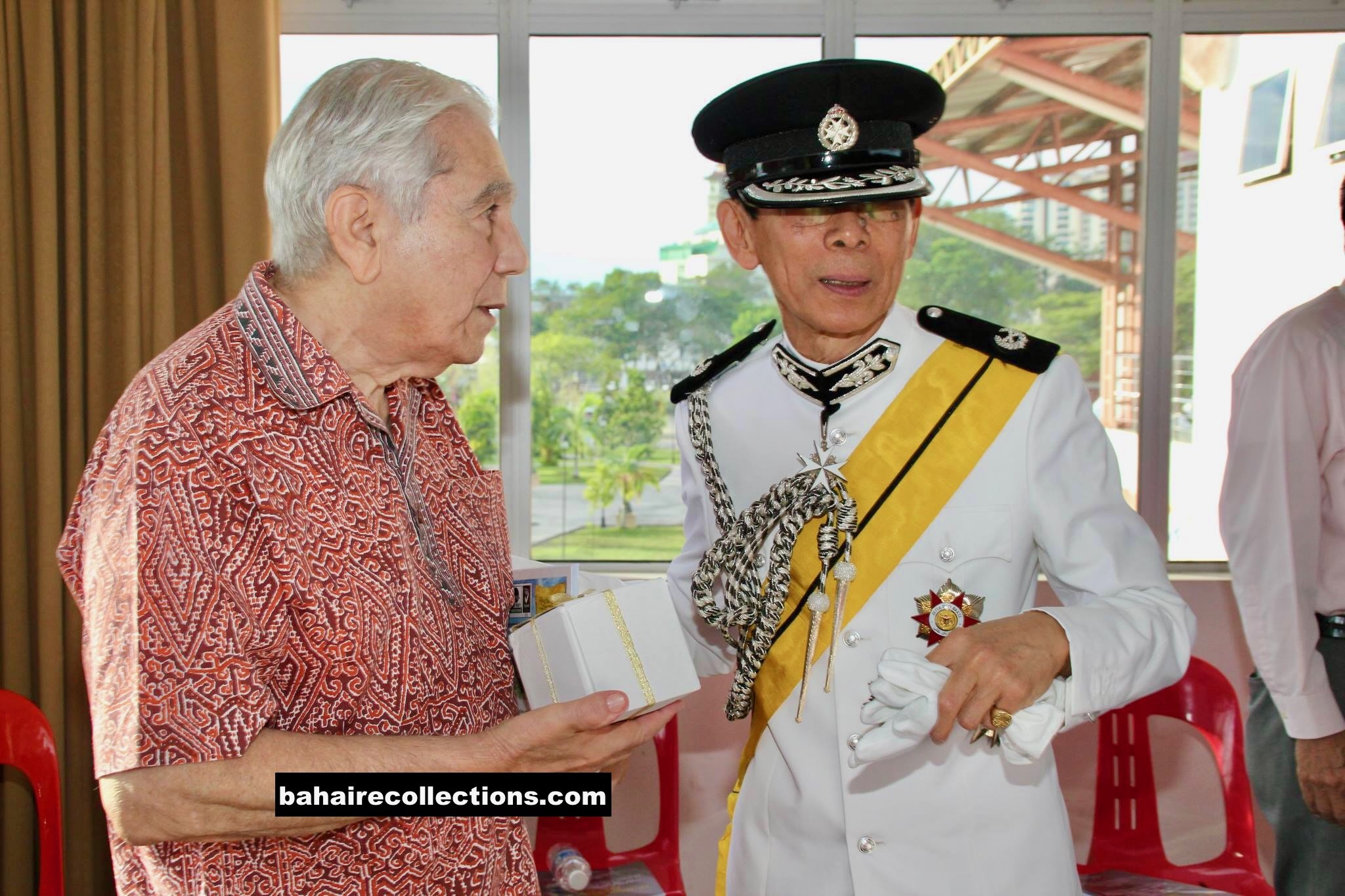 Dr. John with Datuk Seri Ang Lai Soon at the annual march past of the St. Johns Ambulance Sarawak, 2013
Dr. John with Datuk Seri Ang Lai Soon at the annual march past of the St. Johns Ambulance Sarawak, 2013
He was a founding member of several humanitarian associations. In 1981 when the Sarawak school for children with special needs was opened on Ong Tiang Swee Road in Kuching, Dr. John had played a leading role in its creation, through his role on the Social Welfare Council. He was actively involved in the Red Crescent, the Sarawak Cheshire Home (for which he also was in-charge of the website), Social Welfare Council, Society for the Blind, and the Leprosy Association. In his later years, especially when he ceased serving on the Spiritual Assembly of the Bahá’ís of Sarawak, he was actively involved in promotion of inter-Faith understanding through the Malaysian Inter-Faith Network where, as its Chairman, his role stood out in promoting harmony and fellowship among the followers of different faiths. He was sure to be invited for annual festivals of other faiths. He also was an active participant in the Harmony Walk 2017 held at the premises of the Islamic Complex in Kuching – a five kilometer walk that was participated by the Sarawak Sikh Temple, Tua Pek Kong, Kuil Sri Srinivasagar Kaliamman, St. Thomas Church and St. Joseph Church. Leaders of other religious faiths had a special respect and liking for him. Despite his busy schedule, Dr. Fozdar attended coffee-talk sessions at the Sarawak Club where members were eager to seek his company. He would converse with ease on a range of subjects, as he was an avid reader and kept abreast with world events. He always conversed with wit and cheerfulness, and the members loved his company as it would enhance their spirit. Dr. John was actively involved in such humanitarian organisations till his last days, and age, although a constraint, was never a barrier. Even in his last days, when he had to use walking stick to move around, he still attended the Muslim festival of Eid al-Fitr (Hari Raya Puasa) at the Islamic Information Centre in Kuching, and the investiture of the Anglican Bishop for Brunei.

At the visit by Yang Amat Berbahagia Toh Puan Datuk Patinggi Hajjah Raghad Kurdi Taib to Cheshire Home, March 2018

At the Hari Raya Puasa celebrations at the Islamic Information Centre with Chin Chia Chau and Dr. Kalwinder Singh Khaira, President of Sikh Temple, Kuching, 2022
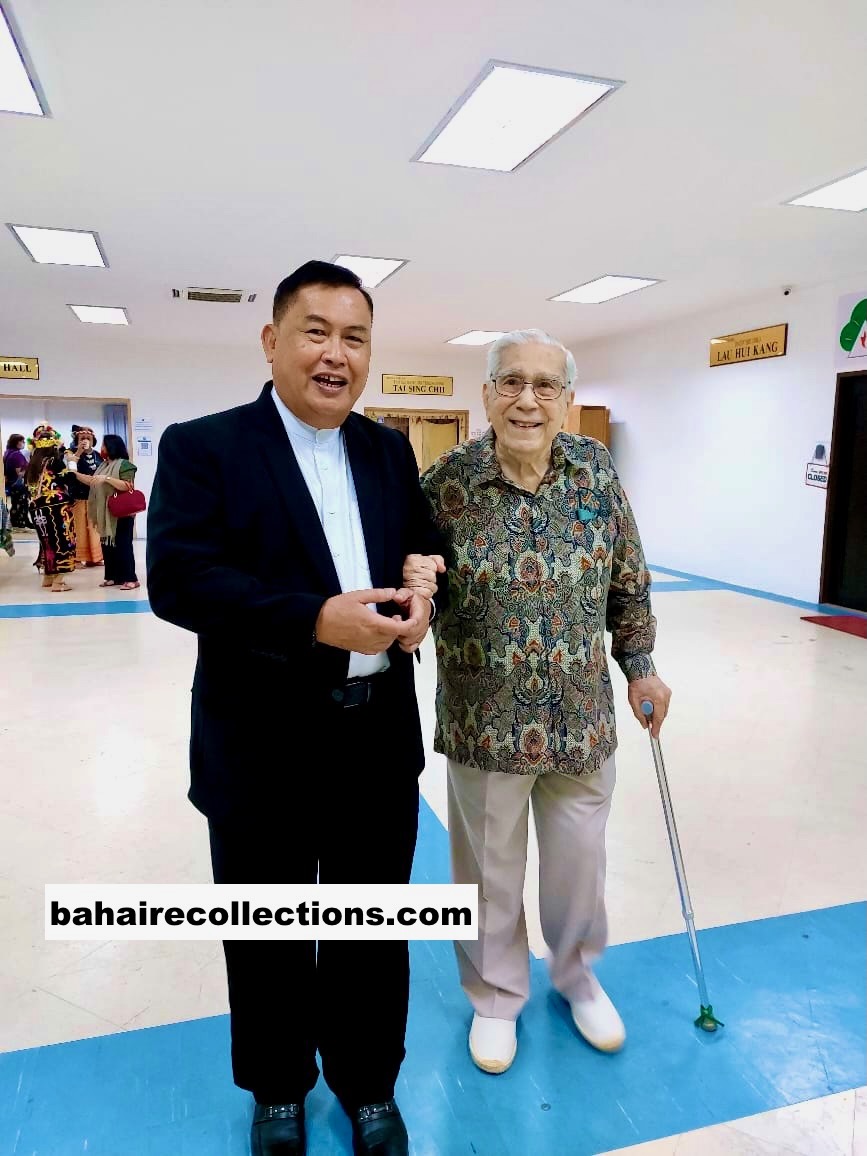
With Mr. Ambrose Linang, Head of All Churches in Sarawak, 2022
Another highly successful area of service was the recognition he got for the Faith in government circles, including getting the Bahá’í Naw-Ruz festival included in the Sarawak Government Gazette. At every opportunity Dr. John did not fail to present the Faith to those highest in authority. He was the leading believer in acquainting those in authority with the tenets of the Faith through uncountable courtesy calls throughout his years in Sarawak. Of great importance among others was his leading a delegation for presenting the book “Proclamation of Baha’u’llah to the Kings” in October 1970 to the Deputy Chief Minister Mr. Stephen Yong, the speaker of Council Negeri Sarawak, Senator William Tan and Mr. Song Thian Cheok, the Mayor of Kuching town. These visits were well mentioned in the midday news of over Radio Sarawak and well covered in the Sarawak Tribune. When the Hand of the Cause Mr. Collis Featherstone and his wife visited Kuching in 1983, Dr. John took him to pay courtesy calls upon high ranking government officials including Dato Sri Celestine Ujang anak Jilan, Speaker of the Sarawak State Legislative Assembly and Datuk Amar Sim Kheng Hong, Deputy Chief Minister of Sarawak, bringing much press publicity for the Faith. In 1984, a delegation led by Counsellor Dr. John paid a courtesy call upon Datuk Sulaiman Daud, the Federal Minister of Education. In 1986, Dr. John played a key role in the presentation of the Promise for World Peace statement to prominent people in Sarawak including the Governor, Tun Datuk Patinggi (Dr.) Haji Ahmad Zaidi Adruce bin Muhammed Noor. He wrote, as a Counsellor then, to individuals and institutions in Sarawak to present the statement to as many prominent people as possible. Dr. John also spoke as the Bahá’í representative at the high-level World Peace Conference organised by the Spiritual Assembly of the Bahá’ís of Malaysia at the Jaya Puri Hotel in Petaling Jaya in January 1986. And on the occasion of the hundredth anniversary of the passing of Bahá’u’lláh in 1992, Counsellor Dr. John accompanied by two members of the Local Spiritual Assembly of Kuching – Mr. Chin Chia Chau and Mr. Dajai Mancha presented the statement on Bahá’u’lláh to Datuk Amar Dr. Wong Soon Kai which was reported in the Sarawak Tribune dated 15 October 1992. In 2014 he also paid a courtesy call upon the Chief Minister of Sabah.

Courtesy call on the Federal Education Minister Datuk Dr. Sulaiman Daud. L-R: Dajai Mancha, Dr. John, Datuk Sulaiman Daud, Winnie Hii Hui Chee and M. Maniam

Counsellor Dr. John presenting the Peace Statement to Datuk Patinggi Hj. Ahmad Zaidi Adruce Bin Mohd Noor, Governor of Sarawak, 1986
Even within the first decade of his stay in Sarawak Dr. John was well recognised in the topmost circles. In 1972 he was awarded the Ahli Bintang Sarawak (ABS) by the Governor of Sarawak on the occasion of the Governor’s birthday. He felt uncomfortable in receiving awards and declined subsequent ones offered. His forging of close contacts with prominent people assisted not only for the propagation of the Faith, but also for protection as well. Dr. John was, by nature, warm-hearted among the believers but was also a strict disciplinarian to ensure the tenets of the Faith were adhered-to and would never entertain any deviation from the straight path, the kind of path that he himself strived to follow. It could be said that he, along with his wife, were the front runners in bringing the Faith out of obscurity in the early days. They developed the early believers and nurtured the community too into maturity. He was highly influential in protecting the Faith and averting possible opposition through his contacts with those in authority.
There is still one more area of service to the humanity where Dr. John shall be remembered, especially the downtrodden in life. He was a panel doctor of the Borneo Company and several others, and yet his concern was much for the poor. He established his polyclinic which, other than providing his own livelihood, also looked after those poor patients who had no financial means to visit doctors. His charges were minimal for them, and many a patient received free treatment. This Dr. John did out of his genuine love for humanity. For this and other humanitarian services, coupled with the aim of upholding the image of the Faith through a Bahá’í life that he led, the Faith is held in high esteem in Sarawak.
Till his last days Dr. John, though not well, was still actively serving the Cause. He communicated with believers and friends in WhatsApp and Facebook, surprisingly computer savvy at that ripe age of 94. To everyone who visited him at his home, he urged them not to sit idle, but to follow the path set by the early believers and serve the Cause especially by teaching. There was always an urgency within his being in serving the Cause, as he believed that not a day should pass without this. He built his life on promoting the Cause of Bahá’u’lláh and made service to Bahá’u’lláh the very centre of his being. Towards the end of his life, Dr. John was involved in drafting a memoir relating to historical events in which he was involved, to keep the history intact and preserved for posterity. This did not materialise as he was taken ill during the course of the preparation of the material. Dr. John was one who had a powerful memory and had details on the development of the Faith in the region at his fingertips. There were two occasions at least, where he kept the audience spellbound when he presented the history of the Faith in the region – one at the opening of the Oceanic Conference of the South China Seas in Singapore on 1 January 1971 and the other at the South East Asia Regional Conference held in Port Dickson in December 1976 where three Hands of the Cause – Mr. Abu’l-Qásim Faizi, Dr. Raḥmatu’lláh Muhájir and Mr. Collis Featherstone were also present. Whenever Bahá’í research students wrote theses about the history of the Faith, the National Spiritual Assembly of Malaysia passed the drafts to Dr. John for his invaluable and authentic comments. Had the memoirs been completed, the Bahá’í community would have had an additional and first-hand source for historical study for the development of the Faith. He would often say that the history of the Faith should be written as it is and not as imagined. He was always alert in ironing out facts from fictions.
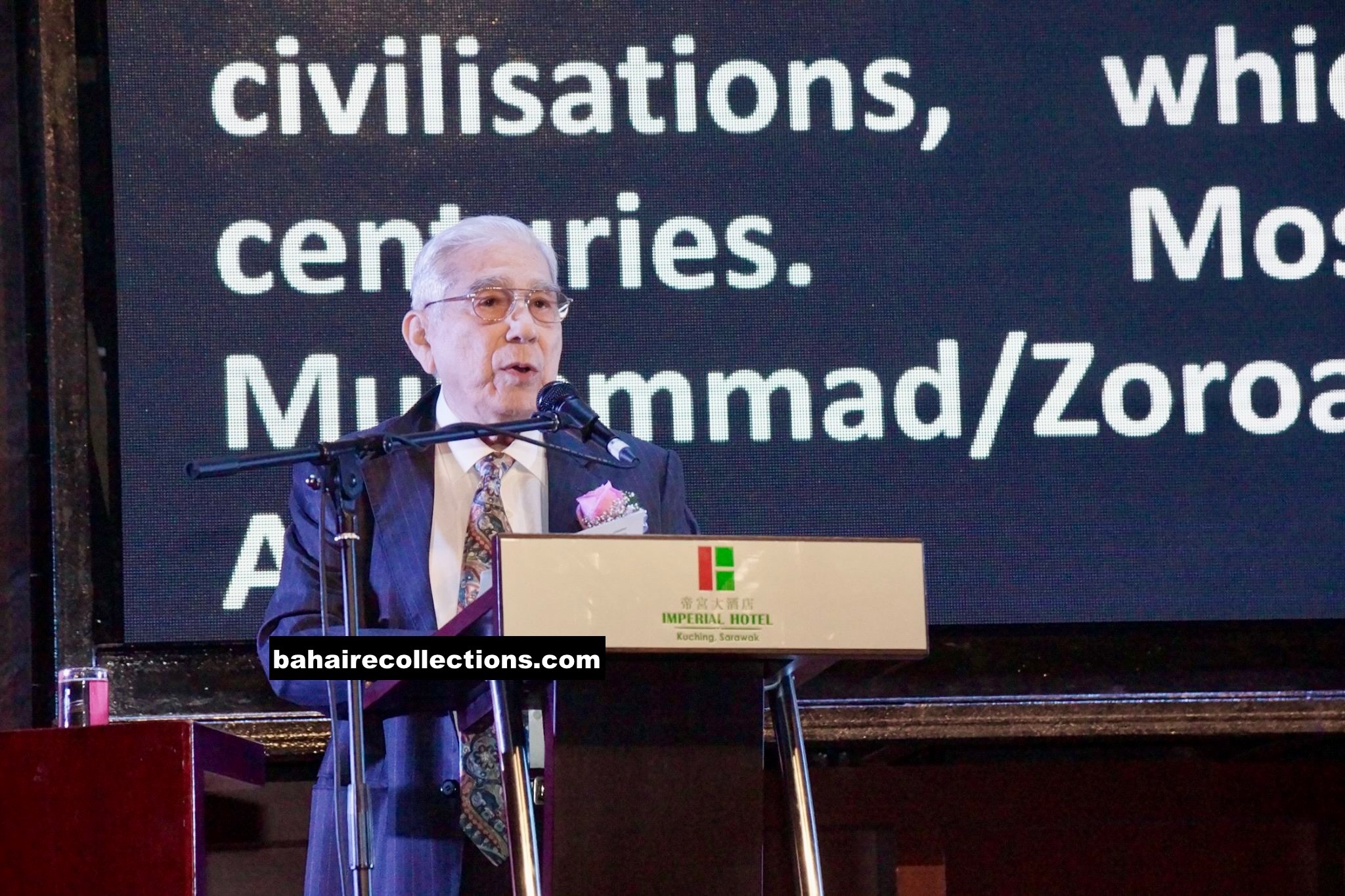 He was an eloquent speaker till his last days on a range of topics. Seen here Dr. John addressing the Malaysian-Buddhist Kalupathi Association Dinner at the Imperial Hotel, Kuching, 2014
He was an eloquent speaker till his last days on a range of topics. Seen here Dr. John addressing the Malaysian-Buddhist Kalupathi Association Dinner at the Imperial Hotel, Kuching, 2014
Sadly, in mid-October 2022 his health deteriorated rapidly over a weekend, and his family members were summoned to be present. Dr. John fell into a coma when at Kuching’s KPJ Hospital with aspiration pneumonia, and the Spiritual Assembly of Sarawak sent out a message asking for prayers. There was a tremendous response from all over the world, from both believers and other well-wishers, assuring prayers and wanting to know his status. Finally, after all his children had arrived, on Saturday 22 October 2022, the precious soul of Dr. John winged its flight to the Unseen Realms, with his sons Kamal and Ian, his daughter-in-law Lorrie, and his granddaughter Lian, with him. Following a highly befitting memorial service held for him on the morning of 25 October at 9 Jalan Rodway, he was taken through the doors of his home for the last time, to be buried at the Bahá’í Cemetery on the Batu Kitang Road just outside of Kuching. Thus ended the exemplary life of a son from an illustrious Bahá’í family. His firmness in the Covenant, his high resolve, strength and vitality of character shall be remembered for generations Perhaps future historians will do justice in recording in greater detail his services for the cause.
A word in conclusion. Accolades after accolades could be placed on the tireless services of this consecrated servant of the Cause. With his passing the Bahá’í world has been deprived of one of its last few living Knights of Bahá’u’lláh. Shoghi Effendi kept a Roll of Honour of all the Knights of Bahá’u’lláh. On 28 May 1992, during the commemoration of the centenary of the ascension of Bahá’u’lláh, the final Roll of Honour was deposited by Rúhíyyih Khánum at the entrance door of the Shrine of Bahá’u’lláh. Dr. John is one of those 254 Knights, who shall forever occupy this unique place and privilege in our history.
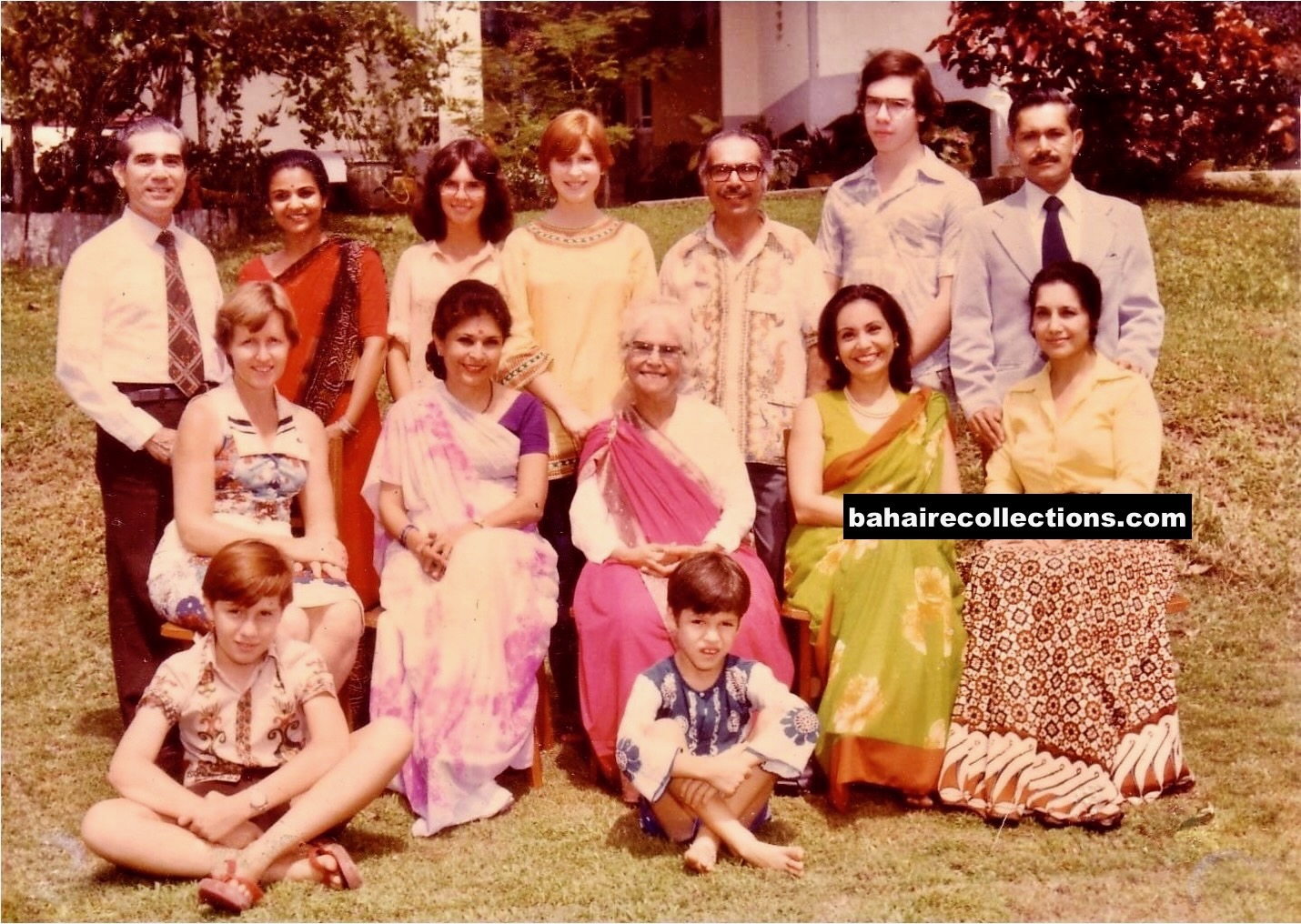 The Fozdar family in Kuching during the South East Asia Regional Bahá’í Conference held in Kuching in 1978. Each member of the Fozdar family shall be remembered for posterity for the indelible services they rendered the Cause
The Fozdar family in Kuching during the South East Asia Regional Bahá’í Conference held in Kuching in 1978. Each member of the Fozdar family shall be remembered for posterity for the indelible services they rendered the Cause
He left a note with his family to place these words on his gravestone when he left the world: “Blessed by his Lord with bounties beyond measure” and the family honored his wishes.

Resting place of Dr. John Fozdar
References:
1. A. Manisegaran, Jewel Among Nations, Splendour Publications, Malaysia, 2003
2. Family of Dr. John Fozdar
A. Manisegaran
26 November 2022
Copyright©bahairecollections.com
You may leave your comments at: info@bahairecollections.com